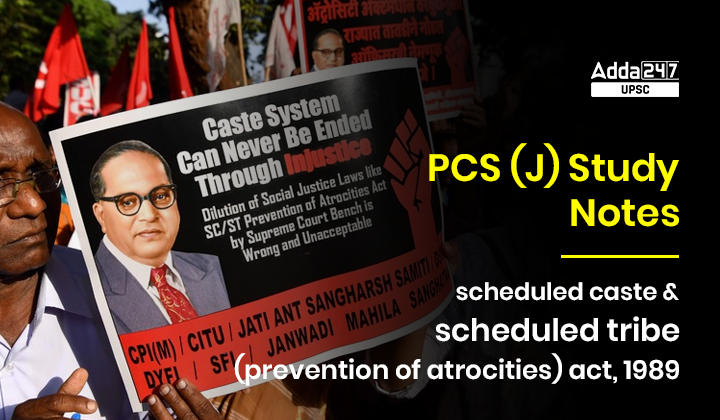Table of Contents
What is the Scheduled Castes and Scheduled Tribes (Prevention of Atrocities) Act, 1989?
Many crimes committed against SC/ST people have been stopped thanks to the provisions of the Scheduled Castes and Scheduled Tribes (Prevention of Atrocities) Act, 1989. To ensure that victims’ rights and privileges are upheld and that they have access to relief, special courts were set up in accordance with the Prevention of Atrocities Act of 1989.
To prevent atrocities against SC/STs, the Government of India passed the Scheduled Castes and Tribes (Prevention of Atrocities) Act in 1989. The Prevention of Atrocities Act of 1989 aimed to protect marginalised groups from persecution and promote their full participation in society. Since January 30, 1990, the Prevention of Atrocities Act of 1989 has been in effect. The Prevention of Atrocities Act of 1989 was created to put an end to crimes committed against members of the Scheduled Castes and Scheduled Tribes by members of other groups.
The SC/ST Act enumerates 37 crimes that are considered to be a violation of the dignity and honour of the scheduled castes and tribes community. Economic, democratic, and social rights, as well as protections against discrimination and exploitation, are all at risk when the legal system is misused.
Salient featured of the Prevention of Atrocities Act 1989
- This Act does not apply to crimes committed between SCs and STs or between STs and SCs.
- Section 3 of the Prevention of Atrocities Act of 1989 lists 37 offences that violate established norms of conduct and violate the dignity of the scheduled castes and tribes. Among these are the exploitation and abuse of legal processes, as well as the denial of economic, democratic, and social rights.
- The legislation not only establishes safeguards for tribal people, but also a system for keeping an eye on how the state responds to violence against SC/ST communities. A 25-person State Monitoring and Vigilance Committee (SVMC) will meet every week, and the District Monitoring and Vigilance Committee (DMVC) will submit a report every month, all in accordance with the Act and Rules (DVMC).
- The government bears ultimate responsibility for the Act’s efficacy, as stated in Section 21 of the Prevention of Atrocities Act (1989). The state government must take action in accordance with the Rules to ensure a smooth and efficient rollout.
- Section 14 of the Prevention of Atrocities Act 1989 designates a Court of Session as a Special Court to try offences under this Act in each district, ensuring that those accused of committing a crime under this law receive a fair trial as soon as possible.
- For each Special Court, the state government must appoint or designate a Special Public Prosecutor to handle cases, as stated in Section 15 of the Prevention of Atrocities Act 1989.
- Section 21(2) of the Prevention of Atrocities Act 1989 ensures victims receive assistance with their social and economic well-being following an atrocity (iii). It specifies how victims and witnesses can receive financial support for living expenses and transportation during the investigation and trial.
- According to Section 23 of the Act, the Central Government may establish regulations for the implementation of the Prevention of Atrocities Act 1989.
- The provisions of Anticipatory Bail do not apply to this Act under Section 18 of the Prevention of Atrocities Act 1989.

अनुसूचित जाति और अनुसूचित जनजाति (अत्याचार निवारण) अधिनियम, 1989 क्या है?
अनुसूचित जाति और अनुसूचित जनजाति (अत्याचार निवारण) अधिनियम, 1989 के प्रावधानों के कारण अनुसूचित जाति/अनुसूचित जनजाति के लोगों के खिलाफ होने वाले कई अपराधों को रोका गया है। यह सुनिश्चित करने के लिए कि पीड़ितों के अधिकार और विशेषाधिकार कायम हैं और उनकी राहत तक पहुंच है, विशेष अदालतों की स्थापना 1989 के अत्याचार निवारण अधिनियम के अनुसार की गई थी।
अनुसूचित जाति/अनुसूचित जनजाति के खिलाफ अत्याचार को रोकने के लिए, भारत सरकार ने 1989 में अनुसूचित जाति और जनजाति (अत्याचार निवारण) अधिनियम पारित किया। 1989 के अत्याचार निवारण अधिनियम का उद्देश्य हाशिए पर रहने वाले समूहों को उत्पीड़न से बचाना और समाज में उनकी पूर्ण भागीदारी को बढ़ावा देना है। 30 जनवरी 1990 से अत्याचार निवारण अधिनियम 1989 प्रभावी है। अन्य समूहों के सदस्यों द्वारा अनुसूचित जाति और अनुसूचित जनजाति के सदस्यों के खिलाफ किए गए अपराधों को समाप्त करने के लिए अत्याचार निवारण अधिनियम 1989 बनाया गया था।
अनुसूचित जाति/अनुसूचित जनजाति अधिनियम में ऐसे 37 अपराधों की गणना की गई है जिन्हें अनुसूचित जाति और जनजाति समुदाय की गरिमा और सम्मान का उल्लंघन माना जाता है। जब कानूनी प्रणाली का दुरुपयोग किया जाता है तो आर्थिक, लोकतांत्रिक और सामाजिक अधिकारों के साथ-साथ भेदभाव और शोषण के खिलाफ सुरक्षा सभी खतरे में हैं।
अत्याचार निवारण अधिनियम 1989 की मुख्य विशेषताएं
- यह अधिनियम एससी और एसटी के बीच या एसटी और एससी के बीच किए गए अपराधों पर लागू नहीं होता है।
- 1989 के अत्याचार निवारण अधिनियम की धारा 3 में 37 ऐसे अपराधों की सूची है जो आचरण के स्थापित मानदंडों का उल्लंघन करते हैं और अनुसूचित जातियों और जनजातियों की गरिमा का उल्लंघन करते हैं। इनमें कानूनी प्रक्रियाओं का शोषण और दुरुपयोग के साथ-साथ आर्थिक, लोकतांत्रिक और सामाजिक अधिकारों का हनन भी शामिल है।
- कानून न केवल जनजातीय लोगों के लिए सुरक्षा उपायों को स्थापित करता है, बल्कि इस बात पर नजर रखने के लिए एक प्रणाली भी है कि राज्य एससी/एसटी समुदायों के खिलाफ हिंसा का जवाब कैसे देता है। एक 25-व्यक्ति राज्य निगरानी और सतर्कता समिति (एसवीएमसी) हर सप्ताह बैठक करेगी, और जिला निगरानी और सतर्कता समिति (डीएमवीसी) हर महीने एक रिपोर्ट प्रस्तुत करेगी, सभी अधिनियम और नियमों (डीवीएमसी) के अनुसार।
अत्याचार निवारण अधिनियम (1989) की धारा 21 के अनुसार अधिनियम की प्रभावकारिता के लिए सरकार की अंतिम जिम्मेदारी है। सुचारू और कुशल रोलआउट सुनिश्चित करने के लिए राज्य सरकार को नियमों के अनुसार कार्रवाई करनी चाहिए।
- अत्याचार निवारण अधिनियम 1989 की धारा 14 प्रत्येक जिले में इस अधिनियम के तहत अपराधों की सुनवाई के लिए एक सत्र न्यायालय को एक विशेष न्यायालय के रूप में नामित करती है, यह सुनिश्चित करती है कि इस कानून के तहत अपराध करने के आरोपियों को जल्द से जल्द निष्पक्ष सुनवाई मिले।
- प्रत्येक विशेष न्यायालय के लिए, राज्य सरकार को मामलों को संभालने के लिए एक विशेष लोक अभियोजक नियुक्त या नामित करना चाहिए, जैसा कि अत्याचार निवारण अधिनियम 1989 की धारा 15 में कहा गया है।
- अत्याचार निवारण अधिनियम 1989 की धारा 21(2) यह सुनिश्चित करती है कि पीड़ितों को अत्याचार के बाद उनके सामाजिक और आर्थिक कल्याण के लिए सहायता प्राप्त हो (iii)। यह निर्दिष्ट करता है कि पीड़ितों और गवाहों को जांच और परीक्षण के दौरान रहने के खर्च और परिवहन के लिए वित्तीय सहायता कैसे प्राप्त हो सकती है।
- अधिनियम की धारा 23 के अनुसार, केंद्र सरकार अत्याचार निवारण अधिनियम 1989 के कार्यान्वयन के लिए विनियम स्थापित कर सकती है।
- अत्याचार निवारण अधिनियम 1989 की धारा 18 के तहत अग्रिम जमानत के प्रावधान इस अधिनियम पर लागू नहीं होते हैं।


 UPSC Prelims Exam Date 2024, Check New E...
UPSC Prelims Exam Date 2024, Check New E...
 UPSC Eligibility Criteria 2024- Age Limi...
UPSC Eligibility Criteria 2024- Age Limi...
 UKPSC RO ARO Result 2024 Out, Download M...
UKPSC RO ARO Result 2024 Out, Download M...







